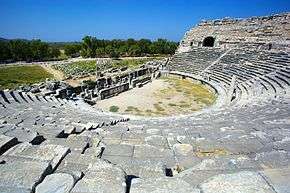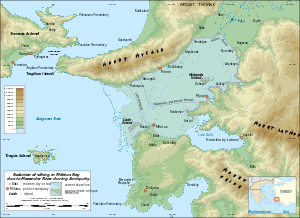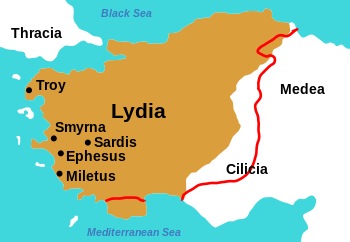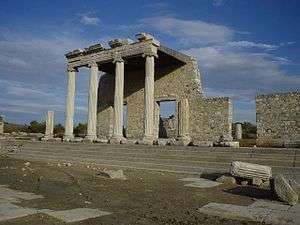Miletus
|
Μί̄λητος Milet | |
 The theater of Miletus | |
 Shown within Turkey | |
| Location | Balat, Didim, Aydın Province, Turkey |
|---|---|
| Region | Caria |
| Coordinates | 37°31′49″N 27°16′42″E / 37.53028°N 27.27833°ECoordinates: 37°31′49″N 27°16′42″E / 37.53028°N 27.27833°E |
| Type | Settlement |
| Area | 90 ha (220 acres) |
| History | |
| Builder | Minoans (later Mycenaeans) on site of the Luwian or Carian city[1][2][3] |
| Site notes | |
| Public access | Yes |
| Website | Miletus Archaeological Site |
Miletus (/maɪˈliːtəs/; Ancient Greek: Μί̄λητος Mīlētos; Hittite transcription Millawanda or Milawata (exonyms); Latin: Miletus; Turkish: Milet) was an ancient Greek city on the western coast of Anatolia, near the mouth of the Maeander River in ancient Caria.[3][4][5] Its ruins are located near the modern village of Balat in Aydın Province, Turkey. Before the Persian invasion in the middle of the 6th century BC, Miletus was considered the greatest and wealthiest of Greek cities.[6][7] In other sources however it is mentioned that the city was much more modest up until the Peloponnesian War (431–404 BC), when, for example, the city state of Samos on the island of Samos opposite Miletus was considered a larger and more important city and harbor at the time. Miletus' greatest wealth and splendor was reached during the Hellenistic era (323–30 BC) and later Roman times.
Evidence of first settlement at the site has been made inaccessible by the rise of sea level and deposition of sediments from the Maeander. The first available evidence is of the Neolithic. In the early and middle Bronze age the settlement came under Minoan influence. Legend has it that an influx of Cretans occurred displacing the indigenous Leleges. The site was renamed Miletus after a place in Crete.
The Late Bronze Age, 13th century BC, saw the arrival of Luwian language speakers from south central Anatolia calling themselves the Carians. Later in that century other Greeks arrived. The city at that time rebelled against the Hittite Empire. After the fall of that empire the city was destroyed in the 12th century BC and starting about 1000 BC was resettled extensively by the Ionian Greeks. Legend offers an Ionian foundation event sponsored by a founder named Neleus from the Peloponnesus.
The Greek Dark Ages were a time of Ionian settlement and consolidation in an alliance called the Ionian League. The Archaic Period of Greece began with a sudden and brilliant flash of art and philosophy on the coast of Anatolia. In the 6th century BC, Miletus was the site of origin of the Greek philosophical (and scientific) tradition, when Thales, followed by Anaximander and Anaximenes (known collectively, to modern scholars, as the Milesian School) began to speculate about the material constitution of the world, and to propose speculative naturalistic (as opposed to traditional, supernatural) explanations for various natural phenomena.
Miletus is the birthplace of the Hagia Sophia's architect (and inventor of the flying buttress) Isidore of Miletus and Thales, a pre-Socratic Greek philosopher (and one of the Seven Sages of Greece) in c. 624 BC.
Geography

The ruins appear on satellite maps at 37°31.8'N 27°16.7'E, about 3 km north of Balat and 3 km east of Batıköy in Aydın Province, Turkey.
In antiquity the city possessed a harbour at the southern entry of a large bay, on which two more of the traditional twelve Ionian cities stood: Priene and Myus. The harbour of Miletus was additionally protected by the nearby small island of Lade. Over the centuries the gulf silted up with alluvium carried by the Meander River. Priene and Myus had lost their harbours by the Roman era, and Miletus itself became an inland town in the early Christian era; all three were abandoned to ruin as their economies were strangled by the lack of access to the sea. There is a Great Harbour Monument where, according to the New Testament account, the apostle Paul stopped on his way back to Jerusalem by boat. He met the Ephesian Elders and then headed out to the beach to bid them farewell, recorded in the book of Acts 20:17-38.
Geology
During the Pleistocene epoch the Miletus region was submerged in the Aegean Sea. It subsequently emerged slowly, the sea reaching a low level of about 130 meters (430 ft) below present level at about 18,000 BP. The site of Miletus was part of the mainland.
A gradual rise brought a level of about 1.75 meters (5 ft 9 in) below present at about 5500 BP, creating several karst block islands of limestone, the location of the first settlements at Miletus. At about 1500 BC the karst shifted due to small crustal movements and the islands consolidated into a peninsula. Since then the sea has risen 1.75 m but the peninsula has been surrounded by sediment from the Maeander river and is now land-locked. Sedimentation of the harbor began at about 1000 BC, and by AD 300 Lake Bafa had been created.[8]
History
Neolithic
The earliest available archaeological evidence indicates that the islands on which Miletus was originally placed were inhabited by a Neolithic population in 3500–3000 BC.[9] Pollen in core samples from Lake Bafa in the Latmus region inland of Miletus suggests that a lightly grazed climax forest prevailed in the Maeander valley, otherwise untenanted. Sparse Neolithic settlements were made at springs, numerous and sometimes geothermal in this karst, rift valley topography. The islands offshore were settled perhaps for their strategic significance at the mouth of the Maeander, a route inland protected by escarpments. The graziers in the valley may have belonged to them, but the location looked to the sea.
Bronze Age
Recorded history at Miletus begins with the records of the Hittite Empire and the Mycenaean records of Pylos and Knossos, in the Late Bronze Age. The prehistoric archaeology of the Early and Middle Bronze Age portrays a city heavily influenced by society and events elsewhere in the Aegean, rather than inland.
Minoan period
Beginning at about 1900 BC artifacts of the Minoan civilization acquired by trade arrived at Miletus.[9] For some centuries the location received a strong impulse from that civilization, an archaeological fact that tends to support but not necessarily confirm the founding legend—that is, a population influx, from Crete. According to Strabo:[10]
Ephorus says: Miletus was first founded and fortified above the sea by Cretans, where the Miletus of olden times is now situated, being settled by Sarpedon, who brought colonists from the Cretan Miletus and named the city after that Miletus, the place formerly being in possession of the Leleges.
The legends recounted as history by the ancient historians and geographers are perhaps the strongest; the late mythographers have nothing historically significant to relate.[11]
Mycenaean period
Miletus was a Mycenaean stronghold on the coast of Asia Minor from ca. 1450 to 1100 BC.[12] In c. 1320 BC, the city supported an anti-Hittite rebellion of Uhha-Ziti of nearby Arzawa. Mursili ordered his generals Mala-Ziti and Gulla to raid Millawanda, and they proceeded to burn parts of it; damage from LHIIIA found on-site has been associated with this raid.[13] In addition the town was fortified according to a Hittite plan.[14]
Miletus is then mentioned in the "Tawagalawa letter", part of a series including the Manapa-Tarhunta letter and the Milawata letter, all of which are less securely dated. The Tawagalawa letter notes that Milawata had a governor, Atpa, who was under the jurisdiction of Ahhiyawa (a growing state probably in LHIIIB Mycenaean Greece); and that the town of Atriya was under Milesian jurisdiction. The Manapa-Tarhunta letter also mentions Atpa. Together the two letters tell that the adventurer Piyama-Radu had humiliated Manapa-Tarhunta before Atpa (in addition to other misadventures); a Hittite king then chased Piyama-Radu into Millawanda and, in the Tawagalawa letter, requested Piyama-Radu's extradition to Hatti.
The Milawata letter mentions a joint expedition by the Hittite king and a Luwiyan vassal (probably Kupanta-Kurunta of Mira) against Miletus, and notes that the city (together with Atriya) were now under Hittite control.
Homer mentions that during the time of the Trojan War, Miletus was an ally of Troy and was city of the Carians, under Naster and Amphimachus.[15]
In the last stage of LHIIIB, the citadel of bronze age Pylos counted among its female slaves a mi-ra-ti-ja, Mycenaean Greek for "women from Miletus", written in Linear B syllabic script.[16] During the collapse of Bronze Age civilization, Miletus was burnt again, presumably by the Sea Peoples.
Dark Age
Mythographers told that Neleus, a son of Codrus the last King of Athens, had come to Miletus after the "Return of the Heraclids" (so, during the Greek Dark Ages). The Ionians killed the men of Miletus and married their widows. This is the mythical commencement of the enduring alliance between Athens and Miletus, which played an important role in the subsequent Persian Wars.
Archaic period

The city of Miletus became one of the twelve Ionian cities of Asia Minor.
Miletus was one of the cities involved in the Lelantine War of the 8th century BC.
Ties with Megara
Miletus is known to have early ties with Megara in Greece. According to some scholars, these two cities had built up a “colonisation alliance”. In the seventh/sixth century BCE they acted in accordance with each other.[17]
Both cities acted under the leadership and sanction of an Apollo oracle. Megara cooperated with that of Delphi. Miletus had her own oracle of Apollo Didymeus Milesios in Didyma. Also, there are many parallels in the political organisation of both cities.[18]
According to Pausanias, the Megarians said that their town owed its origin to Car, the son of Phoroneus, who built the city citadel called 'Caria'.[19] This 'Car of Megara' may or may not be one and the same as the 'Car of the Carians', also known as Car (King of Caria).
In the late 7th century BC, the tyrant Thrasybulus preserved the independence of Miletus during a 12-year war fought against the Lydian Empire.[20] Thrasybulus was an ally of the famous Corinthian tyrant Periander.
Miletus was an important center of philosophy and science, producing such men as Thales, Anaximander and Anaximenes. Referring to this period, religious studies professor F. E. Peters described pan-deism as "the legacy of the Milesians."[21]
By the 6th century BC, Miletus had earned a maritime empire with many colonies, but brushed up against powerful Lydia at home, and the tyrant Polycrates of its neighbour to the west, Samos.
When Cyrus of Persia defeated Croesus of Lydia in the middle of the 6th century BC, Miletus fell under Persian rule. In 499 BC, Miletus's tyrant Aristagoras became the leader of the Ionian Revolt against the Persians. Persia quashed this rebellion and punished Miletus by selling all of the women and children into slavery, killing the men, and expelling all of the young men as eunuchs, thereby assuring that no Miletus citizen would ever be born again. A year afterward, Phrynicus produced the tragedy The Capture of Miletus in Athens. The Athenians fined him for reminding them of their loss.
Classical period


Its gridlike layout became the basic layout for Roman cities.
In 479 BC, the Greeks decisively defeated the Persians on the Greek mainland, and Miletus was freed of Persian rule. During this time several other cities were formed by Milesian settlers, spanning across what is now Turkey and even as far as Crimea.
The eponymous founder of the bawdy Miletian school of literature Aristides of Miletus taught there.
Hellenistic period
In 334 BC, the city was driven from Persian rule along with most of Anatolia by Alexander the Great. In the Hellenistic period the city reached its greatest extent. Within its walls it occupied an area of approximately 90 hectares (220 acres).[22]
Roman period
The New Testament mentions Miletus as the site where the Apostle Paul in AD 57 met with the elders of the church of Ephesus near the close of his Third Missionary Journey, as recorded in Acts of the Apostles (Acts 20:15–38). It is believed that Paul stopped by the Great Harbour Monument and sat on its steps. He may have met the Ephesian elders there and then bid them farewell on the nearby beach. Miletus is also the city where Paul left Trophimus, one of his travelling companions, to recover from an illness (2 Timothy 4:20). Because this cannot be the same visit as Acts 20 (in which Trophimus accompanied Paul all the way to Jerusalem, according to Acts 21:29), Paul must have made at least one additional visit to Miletus, perhaps as late as AD 65 or 66. Paul's previous successful three-year ministry in nearby Ephesus resulted in the evangelization of the entire province of Asia (see Acts 19:10, 20; 1 Corinthians 16:9). It is safe to assume that at least by the time of the apostle's second visit to Miletus, a fledgling Christian community was established in Miletus.
Byzantine period
During the Byzantine age the see of Miletus was raised to an archbishopric and later a metropolitan bishopric. The small Byzantine castle called Palation located on the hill beside the city, was built at this time. Miletus was headed by a curator.[23][24]
Turkish rule
.jpg)
Seljuk Turks conquered the city in the 14th century and used Miletus as a port to trade with Venice.
Finally, Ottomans utilized the city as a harbour during their rule in Anatolia. As the harbour became silted up, the city was abandoned.
Due to ancient and subsequent deforestation, overgrazing (mostly by goat herds), erosion and soil degradation the ruins of the city lie some 10 km (6.2 mi) from the sea with sediments filling the plain and bare hill ridges without soils and trees, a maquis shrubland remaining.
The Ilyas Bey Complex from 1403 with its mosque is an Europa Nostra awarded cultural heritage site in Miletus.
Archaeological excavations
The first excavations in Miletus were conducted by the French archaeologist Olivier Rayet in 1873, followed by the German archaeologists Julius Hülsen and Theodor Wiegand[25][26][27] between 1899 and 1931. Excavations, however, were interrupted several times by wars and various other events. Carl Weickart excavated for a short season in 1938 and again between 1955 and 1957.[28][29][30] He was followed by Gerhard Kleiner and then by Wolfgang Muller-Wiener. Today, excavations are organized by the Ruhr University of Bochum, Germany.
One remarkable artifact recovered from the city during the first excavations of the 19th century, the Market Gate of Miletus, was transported piece by piece to Germany and reassembled. It is currently exhibited at the Pergamon museum in Berlin. The main collection of artifacts resides in the Miletus Museum in Didim, Aydın, serving since 1973.

Colonies of Miletus
Miletus became known for the great number of colonies it founded. It was considered the greatest Greek metropolis and founded more colonies than any other Greek city.[31] Pliny the Elder mentions 90 colonies founded by Miletus in his Natural History (5.112), among them:
- Amisos
- Apolonia
- Dioscurias
- Histria
- Odessos
- Olbia
- Panticapaeum
- Phanagoria
- Phasis
- Pityus
- Sinope
- Tanais
- Theodosia
- Tomis
- Tyras
- Trapezunt
Notable people
- Thales (c. 624 BC – c. 546 BC), Pre-Socratic philosopher
- Anaximander (c. 610 BC – c. 546 BC), Pre-Socratic philosopher
- Cadmus (fl. c. 550 BC), writer
- Anaximenes (c. 585 BC – c. 525 BC), Pre-Socratic philosopher
- Hippodamus (c. 498 — 408 BC), urban planner
- Aspasia (c. 470 – 400 BC) courtesan, and mistress of Pericles, was born in Miletus
- Aristides, writer
- Hecataeus, historian
- Hesychius (fl. 6th century), Greek chronicler and biographer
- Isidore (fl. 4th–5th century), Greek architect
- Aristagoras (fl. 5th–6th century), Tyrant of Miletus
- Leucippus (fl. first half of 5th century BC), philosopher and originator of Atomism (his association with Miletus is traditional, but disputed)
See also
References and sources
- References
- ↑ Alice Mouton; Ian Rutherford; Ilya Yakubovich (7 June 2013). Luwian Identities: Culture, Language and Religion Between Anatolia and the Aegean. BRILL. pp. 435–. ISBN 978-90-04-25341-4.
- ↑ Alan M. Greaves (25 April 2002). Miletos: A History. Taylor & Francis. pp. 71–. ISBN 978-0-203-99393-4.
The political history of Miletos/Millawanda, as it can be reconstructed from limited sources, shows that despite having a material culture dominated by Aegean influences it was more often associated with Anatolian powers such as Arzawa and the Hittites than it was with the presumed Aegean power of Ahhijawa
- 1 2 Sharon R. Steadman; Gregory McMahon; John Gregory McMahon (15 September 2011). The Oxford Handbook of Ancient Anatolia: (10,000-323 BCE). Oxford University Press. p. 369 and 608. ISBN 978-0-19-537614-2.
- ↑ Urban world history: an economic and geographical perspective By Luc-Normand Tellier page79 “The neighboring Greek city of Miletus, located on the Menander river was another terminal of the same route; it exerted certain hegemony over the Black sea trade and created about fifty commercial entrepôts in the Aegean sea and Black sea region...”
- ↑ Carlos Ramirez-Faria (1 January 2007). Concise Encyclopeida Of World History. Atlantic Publishers & Dist. pp. 305–. ISBN 978-81-269-0775-5.
- ↑ A Short History of Greek Philosophy By John Marshall page 11 “For several centuries prior to the great Persian inversion of Greece, perhaps the very greatest and wealthiest city of the Greek world was Miletus”
- ↑ Ancient Greek civilization By David Sansone page 79 “In the seventh and sixth centuries BC the city of Miletus was among the most prosperous and powerful of Greek poleis.”
- ↑ Crouch (2004) page 180.
- 1 2 Crouch (2004) page 183.
- ↑ Book 14 Section 1.6.
- ↑ The late fantasy fiction of Antoninus Liberalis, Metamorphoses XXX 1–2 after Nicander, can be safely disregarded as being in any way history. His entertaining tales have the imaginary character named Miletus fleeing Crete to avoid being forced to become the eromenos of King Minos. He founds the city only after slaying a giant named Asterius, son of Anax, after whom the region known as Miletus was called 'Anactoria', "place of Anax." Anax in Greek means "the king" and Asterius is "starry."
- ↑ Hajnal, Ivo. "Graeco-Anatolian Contacts in the Mycenaean Period". University of Innsbruck. Retrieved 22 September 2013.
- ↑ Christopher Mee, Anatolia and the Aegean in the Late Bronze Age, p. 142
- ↑ Mee, Anatolia and the Aegean, p. 139
- ↑ Iliad, book II
- ↑ Palaeolexicon, Word study tool of ancient languages
- ↑ Alexander Herda (2015), Megara and Miletos: Colonising with Apollo. A Structural Comparison of Religious and Political Institutions in Two Archaic Greek Polis States; see Abstract at Alexander Herda research
- ↑ Alexander Herda (2015), Megara and Miletos: Colonising with Apollo. A Structural Comparison of Religious and Political Institutions in Two Archaic Greek Polis States; see Abstract at Alexander Herda research
- ↑ Paus. i. 39. § 5, i. 40. § 6
- ↑ Miletos, the ornament of Ionia: history of the city to 400 BCE by Vanessa B. Gorman (University of Michigan Press) 2001 – pg 123
- ↑ Francis Edwards Peters (1967). Greek Philosophical Terms: A Historical Lexicon. NYU Press. p. 169. ISBN 0814765521.
- ↑ Chant, Colin (1999). "Greece". In Chant, Colin; Goodman, David. Pre-industrial Cities and Technology. London: Routledge. p. 61. ISBN 9780415200752.
- ↑ The Byzantine aristocracy and its military function, Volume 859 of the Variorum collected studies series, Jean-Claude Cheynet, Ashgate Pub., 2006. ISBN 978-0-7546-5902-0
- ↑ Studies in Byzantine Sigillography, Volume 10, Jean-Claude Cheynet, Claudia Sode, published by Walter de Gruyter, 2010. ISBN 978-3-11-022704-8
- ↑ Olivier Rayet and Thomas, Milet Et Le Golfe Latmique, Fouilles Et Explorations Archeologiques Publ, 1877 (reprint Nabu Press 2010 ISBN 1-141-62992-5
- ↑ Theodor Wiegand and Julius Hülsen [Das Nymphaeum von Milet, Museen zu Berlin 1919] and Kurt Krausem, Die Milesische Landschaft, Milet II, vol. 2, Schoetz, 1929
- ↑ Theodor Wiegand et al., Der Latmos, Milet III, vol. 1, G. Reimer, 1913
- ↑ Carl Weickert, Grabungen in Milet 1938, Bericht über den VI internationalen Kongress für Archäologie, pp. 325-332, 1940
- ↑ Carl Weickert, Die Ausgrabung beim Athena-Tempel in Milet 1955, Istanbuler Mitteilungen, Deutsche Archaeologische Institut, vol. 7, pp.102-132, 1957
- ↑ Carl Weickert, Neue Ausgrabungen in Milet, Neue deutsche Ausgrabungen im Mittelmeergebiet und im Vorderen Orient, pp. 181-96, 1959
- ↑ Colony and Mother City in Ancient Greece By A. J. Graham page 98 “Judged by the number of its colonies Miletus was the greatest of the Greek mother cities. For though some of the more extravagance claims made in antiquate have not been substantiated by modern investigations, her colonies were by far more numerous than those of any other Greek cities.”
- Sources
- Crouch, Dora P. (2004). Geology and Settlement: Greco-Roman Patterns. New York: Oxford University Press. ISBN 9780195083248.
Further reading
- Greaves, Alan M. (2002). Miletos: A History. London: Routledge. ISBN 9780415238465.
External links
| Wikimedia Commons has media related to Miletus. |
- Official website
- Ausgrabungen in Milet official site of the excavations in Miletus by Ruhr-Universität Bochum (German)
- Ancient Coins of Miletus
- Livius picture archive: Miletus
- Greek Inscriptions of Miletus in English translation
- The Theatre at Miletus, The Ancient Theatre Archive, Theatre specifications and virtual reality tour of theatre
 Herbermann, Charles, ed. (1913). "Miletus". Catholic Encyclopedia. New York: Robert Appleton Company.
Herbermann, Charles, ed. (1913). "Miletus". Catholic Encyclopedia. New York: Robert Appleton Company.- Virtual Tour at Ancient Miletus
- Walking the sacred pagan path from Ancient Miletus to Didim
